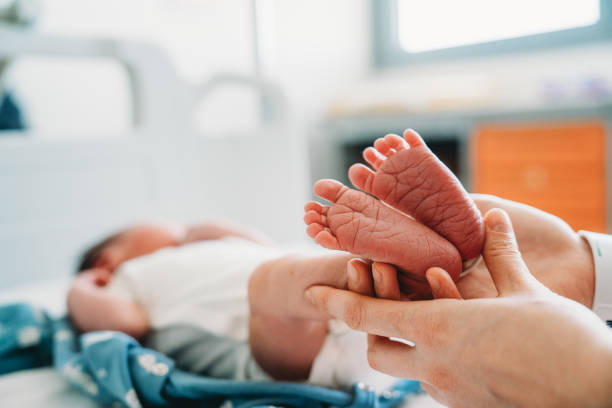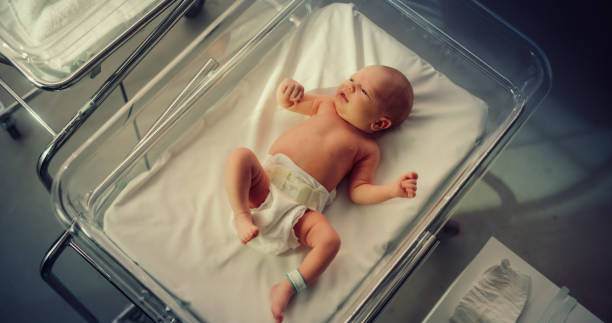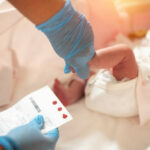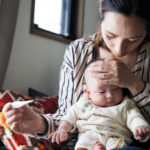The first month of life is a period of rapid growth and critical developmental changes for newborns. While each baby develops at their own pace, there are key milestones that most newborns reach during this time. Monitoring these milestones helps caregivers and healthcare providers assess the baby’s growth and development, identify potential concerns early, and provide timely interventions if necessary.

1. Physical Milestones
1.1. Growth
- Weight: Most newborns regain their birth weight by 10–14 days and gain about 150–200 grams per week.
- Length: Steady growth of about 2.5–3.5 cm (1–1.5 inches) by the end of the first month.
- Head Circumference: Increases by approximately 1–2 cm, reflecting brain growth.
1.2. Reflexes
- Rooting Reflex: Baby turns their head toward a touch on the cheek, helping them locate the breast or bottle.
- Moro Reflex (Startle Reflex): Sudden movements or loud sounds cause the baby to throw out their arms and legs before pulling them back in.
- Grasp Reflex: Baby’s fingers close tightly around objects placed in their palm.
1.3. Motor Skills
- Head Movement: Limited head control; can lift the head briefly when lying on their stomach.
- Movements: Jerky and uncoordinated arm and leg movements.
2. Cognitive and Sensory Milestones
2.1. Vision
- Newborns can focus on objects or faces about 20–30 cm (8–12 inches) away.
- Preference for human faces and high-contrast patterns.
- Begin to track slow-moving objects with their eyes.
2.2. Hearing
- Recognize and respond to familiar voices, particularly the mother’s voice.
- Startle or calm in response to loud or soothing sounds.
2.3. Cognitive Awareness
- Begin to show interest in their surroundings, gazing at bright lights or colorful objects.
- Demonstrate early problem-solving behaviors, such as rooting to locate a food source.
3. Emotional and Social Milestones
3.1. Bonding and Attachment
- Show preference for caregivers, calming when held or hearing a familiar voice.
- Begin to enjoy skin-to-skin contact and cuddling.
3.2. Crying as Communication
- Crying is the primary means of communication for hunger, discomfort, or the need for attention.
- By the end of the first month, babies may start to vary their cries based on their needs.
3.3. Early Smiles
- Reflexive smiles may occur, particularly during sleep.
- Social smiles may begin to develop, especially in response to caregiver interaction.
4. Red Flags to Watch For
While developmental variations are normal, caregivers should consult a healthcare provider if they notice:
- Lack of response to loud noises or voices.
- Difficulty feeding or failure to regain birth weight.
- Limited movement or asymmetry in limb movements.
- Lack of focus or inability to track objects.
- Persistent irritability or lethargy.
5. Supporting Development
5.1. Promote Tummy Time
- Encourage supervised tummy time to strengthen neck, shoulder, and core muscles.
5.2. Engage with Your Baby
- Talk, sing, and read to your baby to support auditory and language development.
- Use eye contact and facial expressions to foster bonding and social skills.
5.3. Provide Sensory Stimulation
- Offer toys with high-contrast patterns or soft sounds to stimulate vision and hearing.
5.4. Ensure a Safe Environment
- Create a calm, quiet space for the baby to sleep and explore.
- Use safe sleep practices, including placing the baby on their back to sleep.
Conclusion
The first month of life is a foundational period for a baby’s physical, cognitive, and emotional development. By understanding and monitoring key developmental milestones, caregivers can support their baby’s growth and identify any potential concerns early. Celebrating these early achievements fosters confidence and strengthens the bond between parents and their newborns, setting the stage for a healthy and happy journey through infancy.







